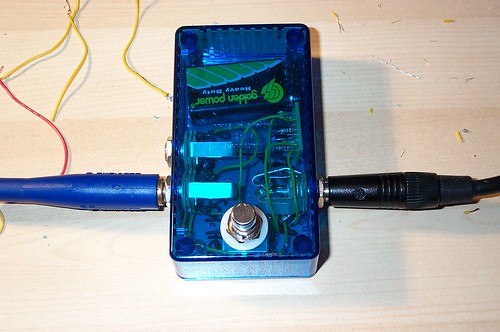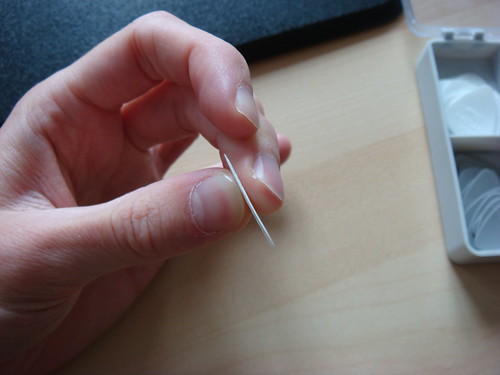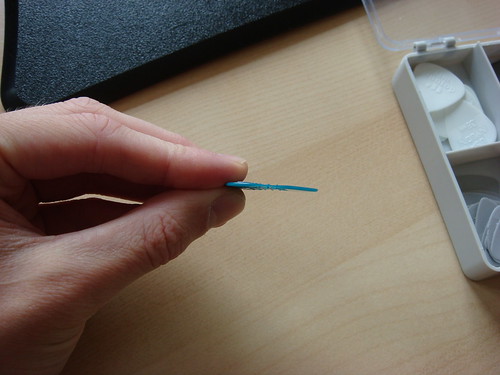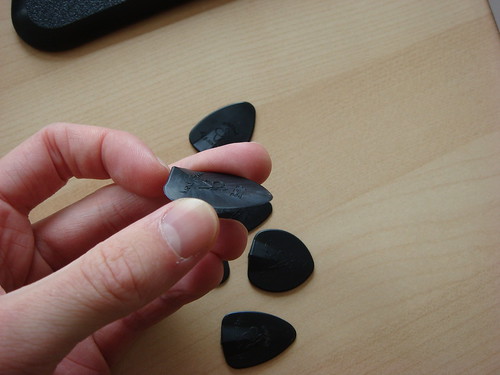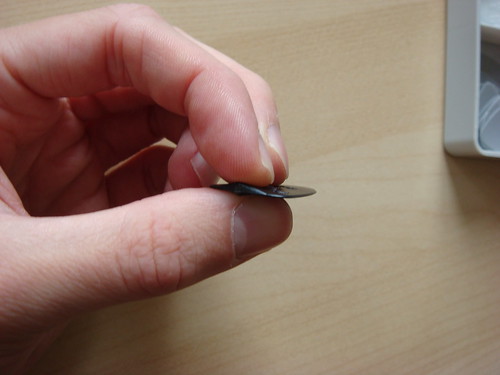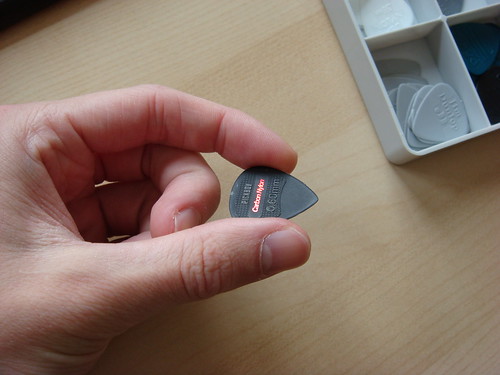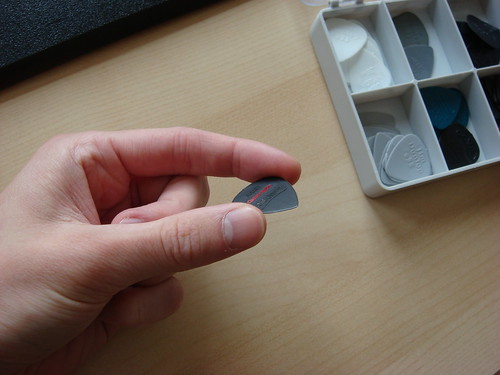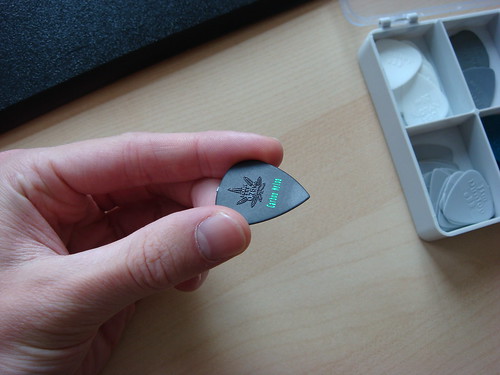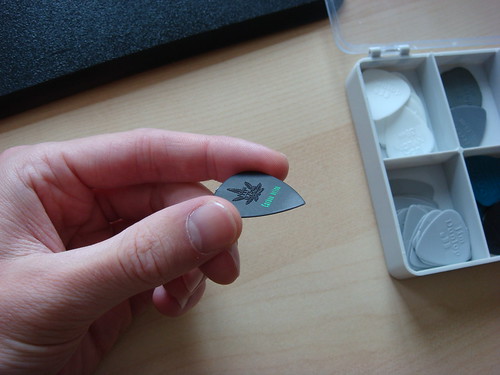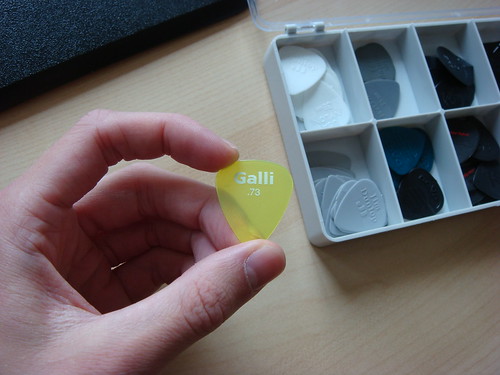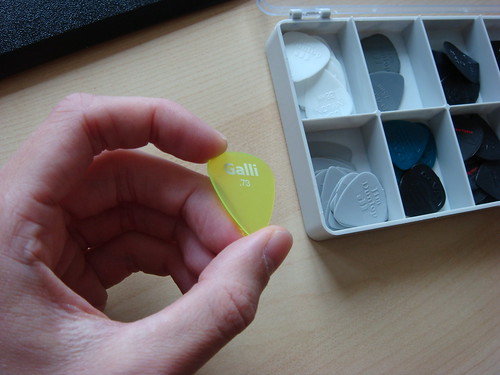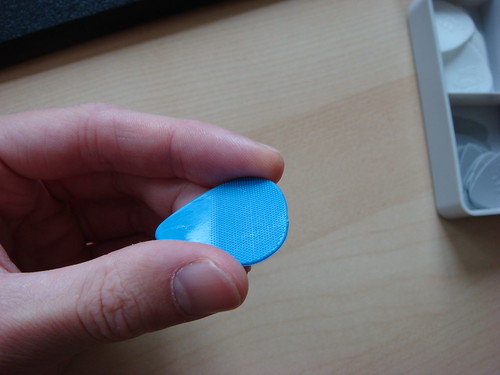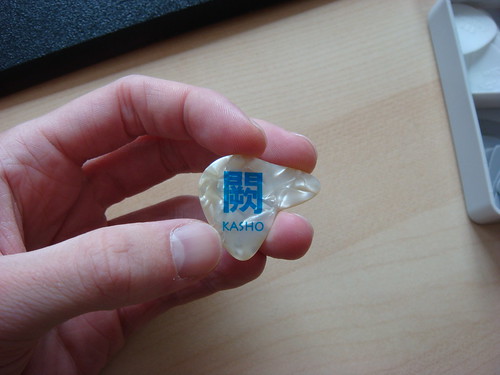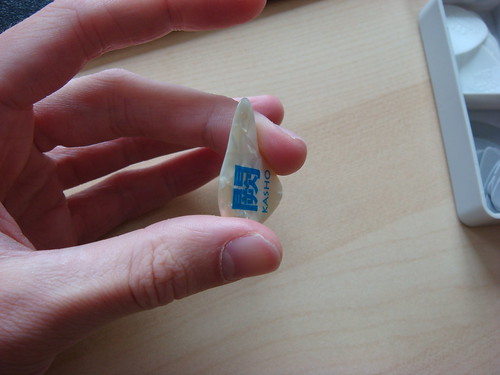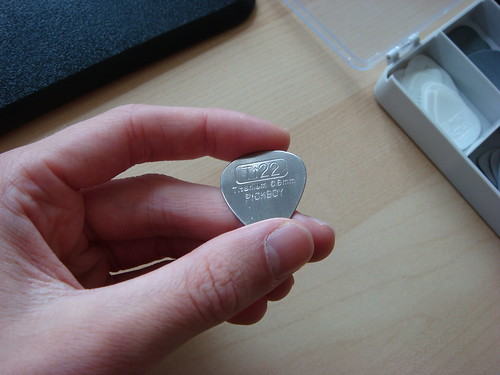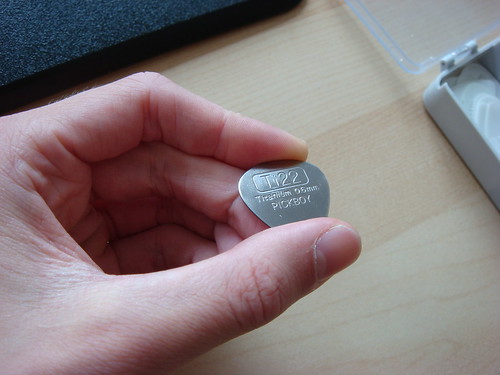JFET Preamp/Splitter
Posted 2006-08-27 in Effects by Johann.
I finished an important part of my Marshall Super Lead-based rig today: A preamp/splitter. The preamp allows me to run longer cable lengths while also providing a little bit of volume boost. It will be placed at the beginning of the chain. The splitter is used to distribute the signal to one of the Super Lead’s two inputs (clean/dirty).
The circuit uses a J201 JFET and follows J. Donald Tillman’s “Discrete FET Guitar Preamp” design with some minor modifications to make the amplification more linear.
The obvious gut shot.
6 comments
Pick tests: Dunlop, Dava, Butterfly, Pickboy, Galli and Kasho picks
Posted 2006-04-30 in Guitar by Johann.
As a guitarist, I keep a lot of different guitar pick types in my pick box. I feel that the sound can vary a lot depending on the pick choice. Some of the factors contributing to the sound of a pick are:
- The pick material.
- The pick thickness.
- The shape of the pick, especially the shape of the tip.
- The size of the pick.
Jim Dunlop USA Nylon
Of these picks, I played the ultra-thin 0.38 mm variety (melts in your mouth, not in your hands) for a long time, but I also have some of the 0.60 mm and 0.73 mm versions. The material is relatively flexible. Probably because of the Nylon, the sound is characterized by a flabby attack.
With the 0.38 mm ones, it is possible to warp the pick to make the tip a little harder. And they work great for black metal tremolo playing – mostly because of their low weight.
Dava Control
The Dava Control picks encourage you to move your fingers between the three zones of the pick. When your finger are closer to the front, the pick becomes more solid. If your fingers move backwards, the pick can swing more. In reality, I don’t know how one would hold the pick to benefit from this flexibility – I certainly can’t. Also, the sound differences (if any) are minor.
Butterfly picks
I ordered a test set from Tone Toys a while ago. These are made from a fairly solid plastic – the smallest version (called “light SST”) is about as solid as the 0.73 mm Jim Dunlop Nylon. The tip of these picks is very round and smooth. The shape is very unique and makes it possible to use the pick in different ways depending on how you grab the pick.
Sound-wise, these have less pick attack, but a very smooth sound. I could imagine these are great for jazz players. Ironically, they also work great for black-metal-style tremolo. Of these, I like the “medium SST.”
Pickboy Edge
Since I got the test set from the aforementioned Tone Toys, the 0.60 mm type instantly became my favorite, so much that I ordered 20 more. What’s so great about them? They are a little bit smaller than the Jim Dunlop ones, the material is very solid and the tip is very sharp. Together with the material, these picks produce a very interesting pick attack that’s completely unlike the flap flap flap of the Nylon picks. Instead, the attack is a very sharp click that sounds an octave higher. A little bit like black metal drummers gluing coins to their bassdrums for that typical click click click bassdrum sound. I found this difference in pick attack to be very interesting to say the least.
Pickboy Carbon Nylon
These seem to be made from a similar material as the Edge picks. They are of the same size as the Jim Dunlop ones, but the material is much stiffer. The attack of the pick isn’t as pronounced as with the Pickboy Edge picks, but it shares similar characteristics. Because of the embossed Cannabis symbol in the pick, the grip is a little better than with the Pickboy Edge picks.
Galli
I have a 0.73 mm and a 1.14 mm pick from Galli. The thicker one sounds slightly scratchy, although the output level appears to be very high.
“Nylon” (producer unknown)
Apparently, the blue version of these picks is played by the Edge of U2. The typical Nylon flap flap flap is still present, but sounds more solid.
Kasho celluloid
These have a very soft feeling and a smoothly rounded tip. This reduces the sharpness of the attack somewhat. The output level is very high though.
Pickboy Ti22 Titanium 0.6 mm
Titanium is quite metal. That’s why these picks are really impossible to bend. The pick attack is very scratchy and your strings probably won’t keep as long.
The bottom line
As a guitar player, you should have lots of picks to experiment with – they’re reasonably cheap. Different picks can sound different and may be more or less adequate for what you play.
For a test of more guitar picks, visit Pick test 2: Pickboy Edge Nylon, Dunlop Tortex, Heriba 133, D’Andrea Jetex.
6 comments
Pages
Page 18 · Page 19 · Page 20 · Page 21 · Page 22 · Page 23 · Page 24
Subscribe
RSS 2.0, Atom or subscribe by Email.
Top Posts
- DynaCloud - a dynamic JavaScript tag/keyword cloud with jQuery
- 6 fast jQuery Tips: More basic Snippets
- xslt.js version 3.2 released
- xslt.js version 3.0 released XML XSLT now with jQuery plugin
- Forum Scanners - prevent forum abuse
- Automate JavaScript compression with YUI Compressor and /packer/
